| # | Topics of the Chapter |
| 1 | Important Definition |
| 2 | Important Differences |
Ans: A cell is the basic structural and functional unit of life. All living organisms, whether plants, animals, or microorganisms, are made up of cells. It is the smallest unit of life that can perform all necessary life processes such as growth, reproduction, and metabolism.
Types of Cells:
Functions of Cells:
Ans: Cell organelles are specialized structures present inside a cell that perform specific functions necessary for the survival and proper functioning of the cell. These organelles act like tiny organs within the cell, helping with processes such as energy production, protein synthesis, waste removal, and transport of materials.
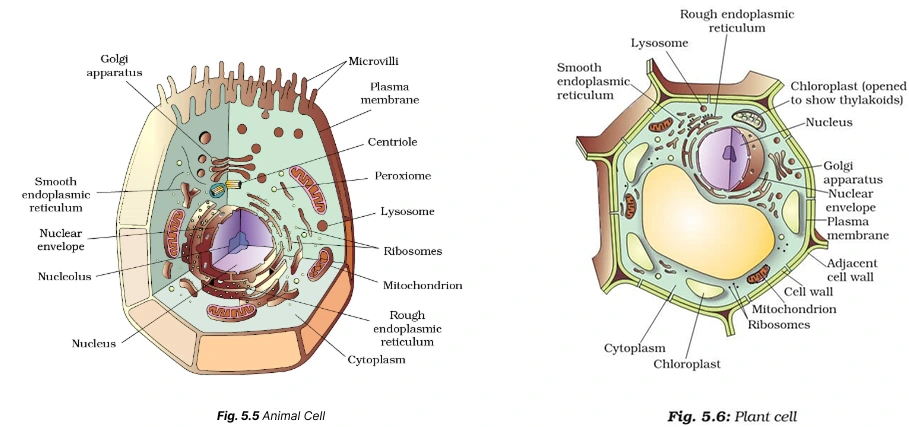
Types of Cell Organelles:
1. Membrane-bound Organelles (Present in Eukaryotic Cells): These organelles are enclosed by membranes and are found in plant and animal cells.
(i). Nucleus – The Control Center
(ii). Mitochondria – The Powerhouse of the Cell
(iii). Endoplasmic Reticulum (ER) – The Transport System
(iv). Golgi Apparatus – The Packaging Unit
(v). Lysosomes – The Digestive System of the Cell
(vi). Vacuoles – The Storage Units
(vii). Plastids (Only in Plant Cells)
2. Non-Membrane Bound Organelles (Present in Both Prokaryotic and Eukaryotic Cells): These organelles do not have a membrane and are found in all types of cells.
(i). Ribosomes – The Protein Factory
(ii). Cytoskeleton – The Framework of the Cell
(iii). Centrosome (Only in Animal Cells)
Ans: A unicellular organism is a living organism that consists of only one cell. This single cell is responsible for carrying out all life processes such as growth, reproduction, metabolism, and response to stimuli.
Characteristics of Unicellular Organisms
i. Single Cell Structure – The entire organism is made up of just one cell.
ii. Performs All Life Functions – The single cell carries out respiration, digestion, excretion, and reproduction.
iii. Microscopic in Size – Most unicellular organisms are very small and can only be seen under a microscope.
iv. Simple Body Structure – They lack complex organs but have specialized structures within the cell.
v. Can Live Independently – They do not depend on other cells for survival.
Examples of Unicellular Organisms:
i. Bacteria 🦠
- Type: Prokaryotic (No nucleus)
- Example: Escherichia coli (E. coli)
- Features: Simple structure, reproduce quickly, some are beneficial, and some can cause diseases.
ii. Amoeba
- Type: Eukaryotic (Has nucleus)
- Features: Moves using pseudopodia (false feet), engulfs food by phagocytosis.
iii. Paramecium
Type: Eukaryotic
Features: Moves using cilia (tiny hair-like structures), has a food vacuole for digestion.
iv. Euglena
- Type: Eukaryotic
- Features: Can perform photosynthesis like plants but also eat food like animals, moves using a flagellum.
v. Yeast 🍞
- Type: Eukaryotic (Fungi)
- Features: Used in fermentation to make bread and alcohol, reproduces by budding.
Ans: A multicellular organism is a living organism made up of more than one cell. In these organisms, cells work together to perform various functions, and they are specialized for different tasks.
Characteristics of Multicellular Organisms:
(i). Multiple Cells – Composed of many cells that are organized into tissues, organs, and systems.
(ii). Cell Specialization – Different cells perform specific functions (e.g., muscle cells for movement, nerve cells for communication).
(iii). Complex Body Structure – They have different levels of organization:
Cells → Tissues → Organs → Organ Systems → Organism
(iv). Larger in Size – They grow bigger than unicellular organisms due to cell division.
(v). Longer Lifespan – Since damage to one cell doesn’t affect the entire organism, they live longer than unicellular organisms.
(vi). Cannot Survive Independently – A single cell cannot live on its own; it needs to work with other cells.
Examples of Multicellular Organisms:
(i). Humans 🧑
- Composed of trillions of cells organized into tissues and organs.
- Have systems like digestive, nervous, and respiratory for survival.
(ii). Animals 🐶
- Examples: Dogs, Cats, Elephants, Birds, and Fish.
- Have specialized organs like lungs, heart, and brain.
(iii). Plants 🌿
- Examples: Mango Tree, Rose Plant, Sunflower.
- Have tissues like xylem and phloem for transport of water and food.
(iv). Fungi 🍄
- Example: Mushrooms, Molds.
- Their body is made of many cells arranged in thread-like structures called hyphae.
Ans: The plasma membrane, also known as the cell membrane, is the outermost covering of a cell that separates the cell's internal environment from the external environment. It is a thin, flexible, and selectively permeable membrane that controls the movement of substances in and out of the cell.
Structure of Plasma Membrane: The plasma membrane is made up of a phospholipid bilayer with embedded proteins, cholesterol, and carbohydrates.
i. Phospholipid Bilayer – Forms the basic structure of the membrane, allowing flexibility.
ii. Proteins – Help in transport, signaling, and structural support.
iii. Cholesterol – Maintains membrane fluidity.
iv. Carbohydrates – Play a role in cell recognition and communication.
Functions of Plasma Membrane:
i. Selective Permeability – Controls what enters and exits the cell, allowing only certain substances to pass through.
ii. Protection – Acts as a barrier, protecting the internal contents of the cell.
iii. Communication – Contains receptors that help in cell signaling and communication.
iv. Endocytosis & Exocytosis – Helps in engulfing food particles (endocytosis) and removing waste (exocytosis).
v. Maintains Shape – Provides structural support to the cell.
Why is the Plasma Membrane Called Selectively Permeable?
i. The plasma membrane allows some substances (like oxygen and nutrients) to pass freely, while it restricts others (like harmful toxins).
ii. This property helps maintain homeostasis (stable internal conditions) in the cell.
iii. Diagram:
Ans: One of the following three things could happen:
(i). If the medium surrounding the cell has a higher water concentration than the cell, meaning that the outside solution is very dilute, the cell will gain water by osmosis. Such a solution is known as a hypotonic solution.
Water molecules are free to pass across the cell membrane in both directions, but more water will come into the cell than will leave. The net (overall) result is that water enters the cell. The cell is likely to swell up.
(ii). If the medium has exactly the same water concentration as the cell, there will be no net movement of water across the cell membrane. Such a solution is known as an isotonic solution.
Water crosses the cell membrane in both directions, but the amount going in is the same as the amount going out, so there is no overall movement of water. The cell will stay the same size.
(iii). If the medium has a lower concentration of water than the cell, meaning that it is a very concentrated solution, the cell will lose water by osmosis. Such a solution is known as a hypertonic solution.
Ans: The cell wall is a rigid, outermost layer found in plant cells, fungi, bacteria, and some protists. It provides structural support, protection, and shape to the cell. The cell wall is located outside the plasma membrane and is a distinguishing feature of plant cells (not found in animal cells).
Structure of the Cell Wall:
The composition of the cell wall varies in different organisms:
i. Plants – Made of cellulose, a strong carbohydrate fiber.
ii. Fungi – Made of chitin (same material found in insect exoskeletons).
iii. Bacteria – Made of peptidoglycan.
iv. Algae – Made of cellulose, glycoproteins, or silica (in diatoms).
Functions of the Cell Wall:
i. Provides Strength and Support – Maintains the shape of the cell and prevents it from collapsing.
ii. Protects the Cell – Acts as a barrier against mechanical damage and pathogens.
iii. Prevents Over-Expansion – Regulates water intake and prevents the cell from bursting in a hypotonic solution.
iv. Allows Free Exchange of Substances – Has small pores (plasmodesmata in plant cells) that allow materials to pass between cells.
v. Helps in Cell Communication – Plasmodesmata connect plant cells, enabling nutrient and signal exchange.
Definition of plasmolysis:
When a living plant cell loses water through osmosis there is shrinkage or contraction of the contents of the cell away from the cell wall. This phenomenon is known as plasmolysis.
Ans: The nucleus is a membrane-bound organelle found in eukaryotic cells (plants, animals, fungi, and protists). It is often called the "control center" of the cell because it regulates all cellular activities and stores genetic material (DNA).
In some organisms like bacteria, the nuclear region of the cell may be poorly defined due to the absence of a nuclear membrane. Such an undefined nuclear region containing only nucleic acids is called a nucleoid.
Structure of the Nucleus
The nucleus consists of the following main parts:
i. Nuclear Membrane (Nuclear Envelope)
- A double-layered membrane that separates the nucleus from the cytoplasm.
- Has nuclear pores that allow the exchange of materials (RNA, proteins) between the nucleus and cytoplasm.
ii. Nucleoplasm (Nuclear Sap)
- The jelly-like fluid inside the nucleus that contains chromatin and the nucleolus.
- Provides a medium for nuclear components to move and function.
iii. Chromatin (DNA + Proteins)
- A thread-like structure containing DNA and proteins.
- During cell division, chromatin condenses to form chromosomes that carry genetic information.
iv. Nucleolus
- A dense, round structure inside the nucleus.
- Main function: Produces ribosomes, which help in protein synthesis.
Functions of the Nucleus
i. Controls Cell Activities – Regulates cell growth, metabolism, and reproduction.
ii. Stores Genetic Information – Contains DNA, which determines the characteristics of an organism.
iii. Helps in Cell Division – Plays a key role in mitosis (cell growth) and meiosis (reproduction).
iv. Synthesizes RNA & Ribosomes – The nucleolus produces ribosomes, essential for making proteins.
v. Passes Hereditary Traits – The DNA in the nucleus carries genetic information from parents to offspring.
Does Every Cell Have a Nucleus?
i. Eukaryotic Cells (Plants, Animals, Fungi, Protists) – Have a well-defined nucleus.
ii. Prokaryotic Cells (Bacteria, Archaea) – Lack a true nucleus, but have a nucleoid, where DNA is found.
iii. Mature Red Blood Cells (RBCs) in mammals do not have a nucleus to create more space for oxygen transport.
Ans: Eukaryotic cells are advanced, complex cells that have a well-defined nucleus and membrane-bound organelles. They are found in plants, animals, fungi, and protists.
Characteristics of Eukaryotic Cells
i. Well-Defined Nucleus
- Contains DNA inside a nuclear membrane.
- Controls all cell activities and genetic functions.
ii. Membrane-Bound Organelles
- Have specialized structures like the mitochondria, Golgi apparatus, endoplasmic reticulum, and lysosomes.
- Each organelle has a specific function.
iii. Larger in Size
- Usually 10–100 µm in size (much larger than prokaryotic cells).
iv. Multicellular or Unicellular
- Can exist as single cells (protists like Amoeba, Paramecium) or multicellular organisms (plants, animals, fungi).
v. Cell Division by Mitosis & Meiosis
- Eukaryotic cells divide using mitosis (for growth) and meiosis (for reproduction).
Structure of Eukaryotic Cells
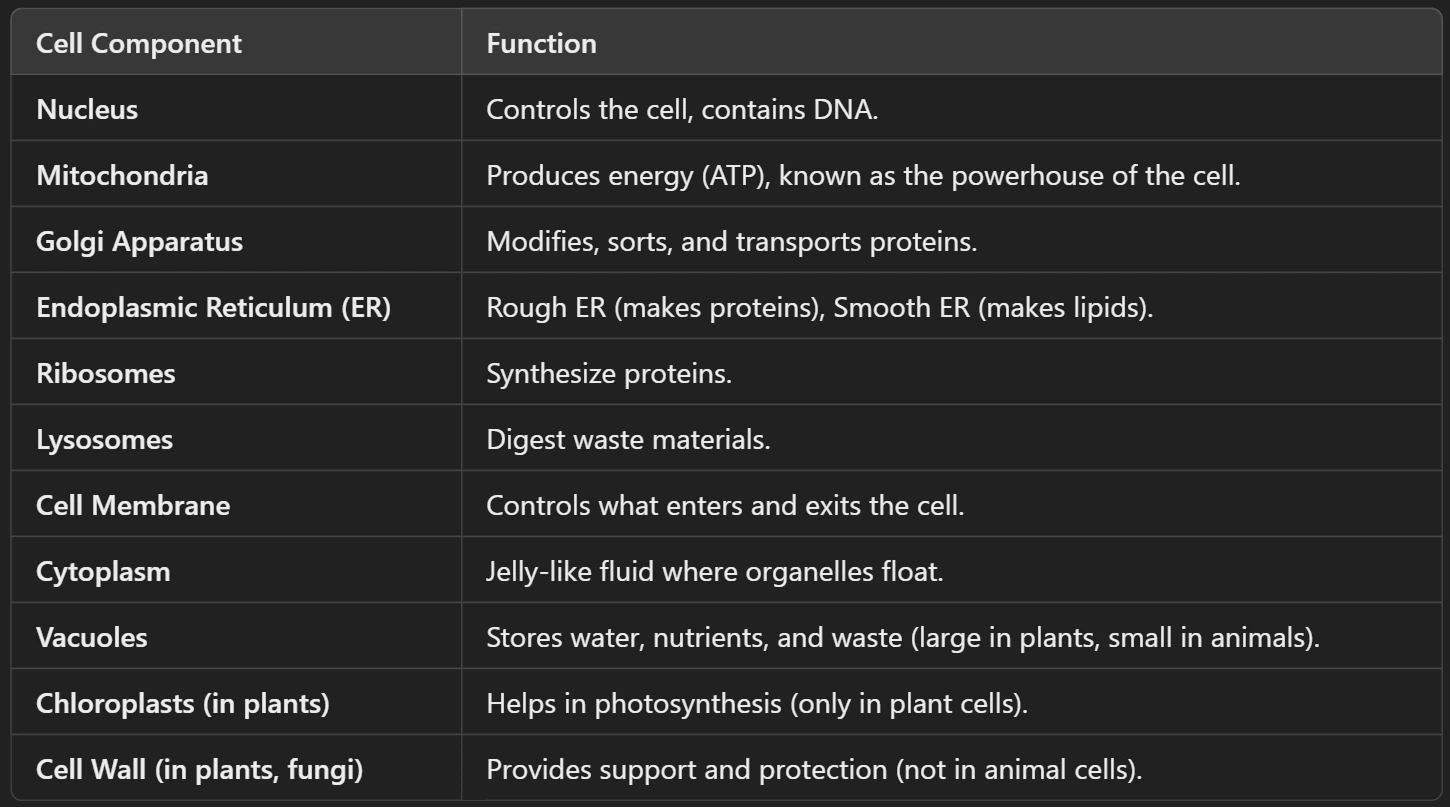
Examples of Eukaryotic Cells
- Animal Cells – Human, Dog, Elephant cells.
- Plant Cells – Mango Tree, Grass, Algae cells.
- Fungi – Yeast, Mushroom cells.
- Protists – Amoeba, Paramecium.
Ans: Prokaryotic cells are simple, small, and primitive cells that lack a well-defined nucleus and membrane-bound organelles. These cells are mainly found in bacteria and archaea and are considered the earliest forms of life on Earth.
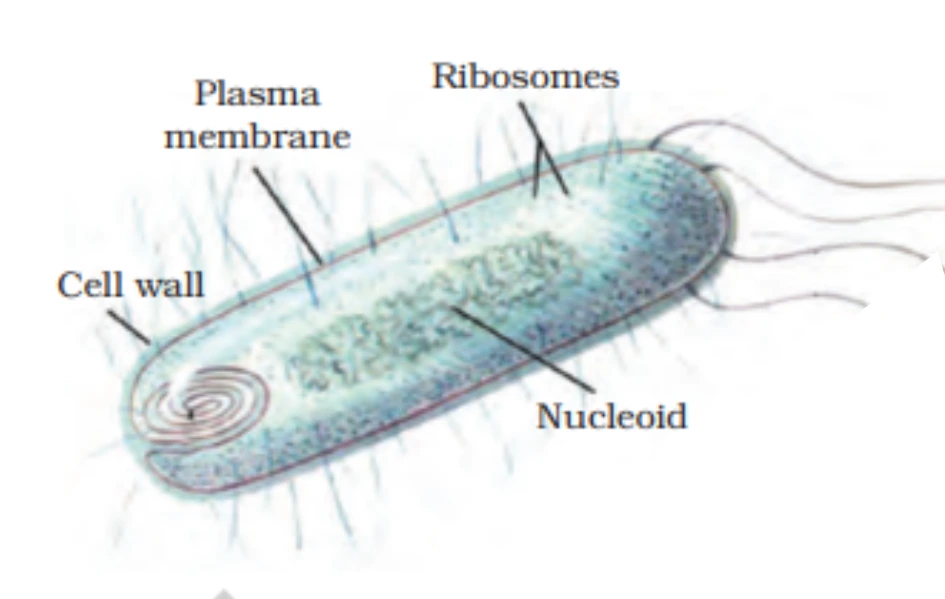
Characteristics of Prokaryotic Cells
i. No True Nucleus: DNA is present in a region called the nucleoid, but it is not enclosed by a nuclear membrane.
ii. No Membrane-Bound Organelles: Lacks specialized structures like mitochondria, Golgi apparatus, and endoplasmic reticulum.
iii. Small in Size: Typically 0.1–5 µm in size (much smaller than eukaryotic cells).
iv. Unicellular Organisms: Prokaryotic cells are usually single-celled organisms, but some (like cyanobacteria) form colonies.
v. Cell Division by Binary Fission: They reproduce through a simple process called binary fission, not mitosis or meiosis.
Structure of Prokaryotic Cells
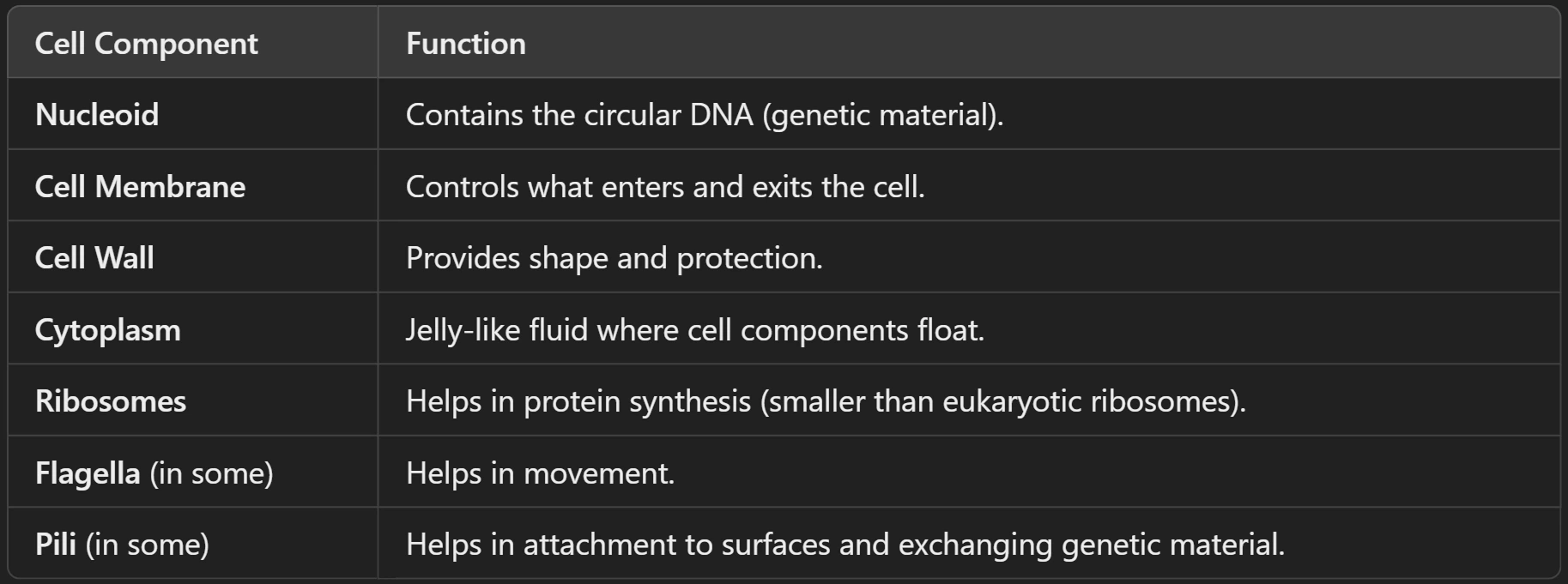
Examples of Prokaryotic Cells
- Bacteria – E. coli, Streptococcus, Lactobacillus
- Archaea – Methanogens, Halophiles (found in extreme environments)
- Cyanobacteria – Blue-green algae (photosynthetic bacteria)
Ans: Cytoplasm is the jelly-like, semi-fluid substance found inside the cell, between the cell membrane and the nucleus. It contains all the cell organelles and is essential for various cellular functions.
Characteristics of Cytoplasm
i. Jelly-like Substance: It has a semi-liquid, gel-like consistency that allows organelles to stay suspended.
ii. Present in All Cells: Found in both prokaryotic (bacteria) and eukaryotic (plants, animals, fungi, protists) cells.
iii. Composition: Made up of water (about 80%), proteins, enzymes, salts, and organic molecules.
iv. Site of Cellular Activities: Many chemical reactions (like glycolysis) take place in the cytoplasm.
v. Supports and Protects Organelles: Acts as a cushion to prevent damage to cell components.
Components of Cytoplasm
i. Cytosol
- The fluid part of the cytoplasm (without organelles).
- Contains enzymes, ions, and molecules needed for cell functions.
ii. Cell Organelles
- Floating structures like the nucleus, mitochondria, ribosomes, lysosomes, etc.
iii. Inclusions
- Temporary stored substances like starch, proteins, lipids, and pigments.
Functions of Cytoplasm

Ans: The Endoplasmic Reticulum (ER) is a network of membranous tubules and sacs that extends throughout the cytoplasm of a eukaryotic cell. It plays a crucial role in the transport, synthesis, and modification of proteins and lipids.
Types of Endoplasmic Reticulum: The ER is divided into two types based on its structure and function:
i. Rough Endoplasmic Reticulum (RER)
- Structure: Appears "rough" due to the presence of ribosomes attached to its surface.
- Function:
🔹Protein synthesis: The ribosomes on RER synthesize proteins.
🔹Protein modification: Helps in folding and processing of proteins before they are sent to other parts of the cell.
🔹Transport: Sends proteins to the Golgi apparatus for further processing.
- Found in: Cells that produce a high amount of proteins, like pancreatic cells and antibody-producing cells.
ii. Smooth Endoplasmic Reticulum (SER)
- Structure: Lacks ribosomes, making it look "smooth".
- Function:
🔹Lipid and steroid synthesis: Produces fats, phospholipids, and steroid hormones.
🔹Detoxification: Helps in breaking down drugs, alcohol, and toxins (especially in liver cells).
🔹Calcium storage: Stores calcium ions, which are important for muscle contraction and cell signaling.
- Found in: Cells that produce a high amount of lipids or need detoxification, like liver cells and adrenal gland cells.
Functions of Endoplasmic Reticulum

Ans: The Golgi Apparatus, also called the Golgi Complex or Golgi Body, is a membrane-bound organelle found in eukaryotic cells. It functions as the processing, packaging, and distribution center of proteins and lipids synthesized in the endoplasmic reticulum (ER).
Structure of Golgi Apparatus
i. Stack of Flattened Sacs: The Golgi Apparatus consists of flattened, membrane-bound sacs called cisternae arranged in a stack.
ii. Two Faces of Golgi Body:
🔹Cis Face (Receiving Side): Faces the endoplasmic reticulum and receives newly synthesized proteins and lipids.
🔹Trans Face (Shipping Side): Faces the cell membrane and exports processed materials to different parts of the cell or outside.
iii. Vesicles: Small membrane-bound sacs that transport proteins and lipids between the ER, Golgi, and final destinations.
Functions of Golgi Apparatus
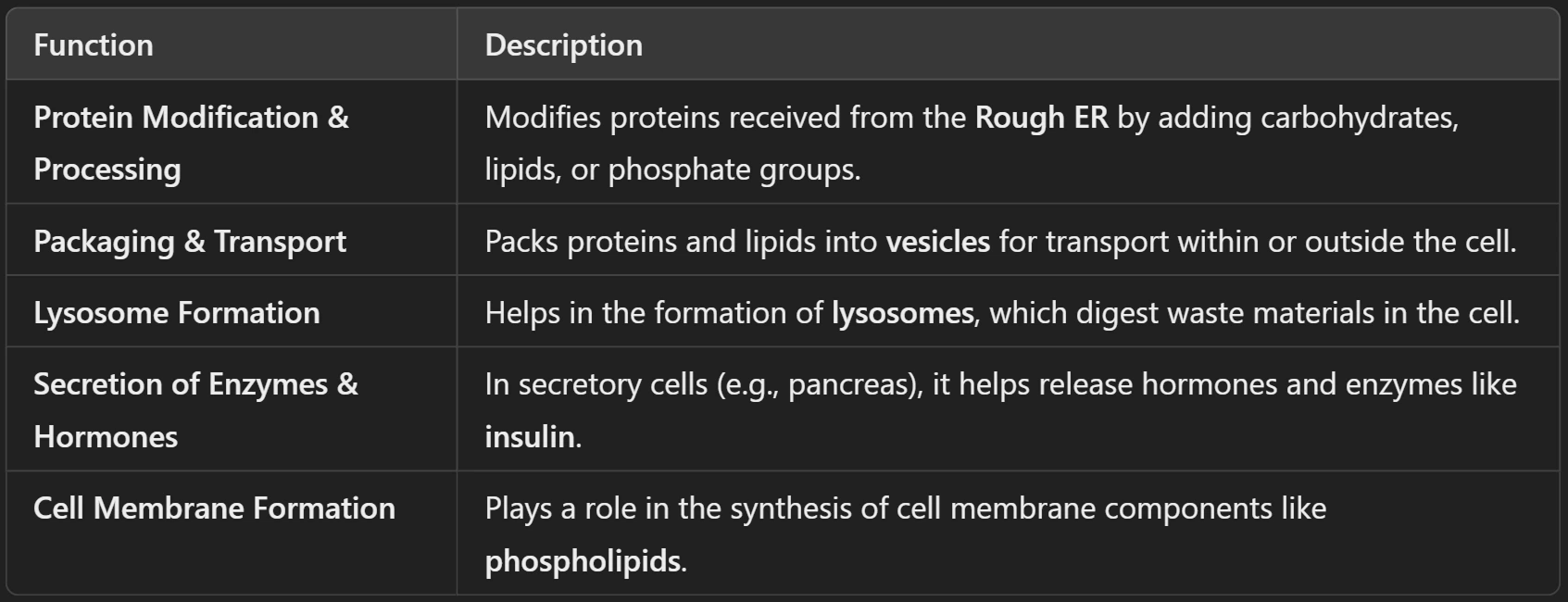
Steps of Protein Transport in Golgi Apparatus
i. Proteins & Lipids are synthesized in the endoplasmic reticulum (ER).
ii. Transported to the cis face of the Golgi Apparatus via vesicles.
iii. Undergo modifications like glycosylation (addition of sugars) or phosphorylation (addition of phosphate).
iv. Sorted and packaged into vesicles.
v. Sent to their final destination:
🔹Plasma membrane for secretion.
🔹Lysosomes for digestion.
🔹Other organelles for cell functioning.
Ans: A lysosome is a membrane-bound organelle found in eukaryotic cells that contains digestive enzymes. It functions as the waste disposal system of the cell, breaking down unwanted materials, damaged organelles, and invading pathogens.
Structure of Lysosome
🔹Small, spherical, sac-like vesicles enclosed by a single membrane.
🔹Contain hydrolytic enzymes like proteases, lipases, and nucleases that help in breaking down biomolecules.
🔹Formed from the Golgi apparatus.
🔹Found in animal cells and some plant cells (though rare in plants).
Types of Lysosomes
i. Primary Lysosomes – Contain inactive digestive enzymes, not yet involved in digestion.
ii. Secondary Lysosomes – Form when primary lysosomes fuse with vesicles containing food or waste.
Why is the Lysosome Called the "Suicidal Bag" of the Cell?
Lysosomes are called "suicidal bags" because they contain digestive enzymes that can break down cellular components. If a lysosome bursts inside the cell, these enzymes can destroy the cell itself.
Functions of Lysosome
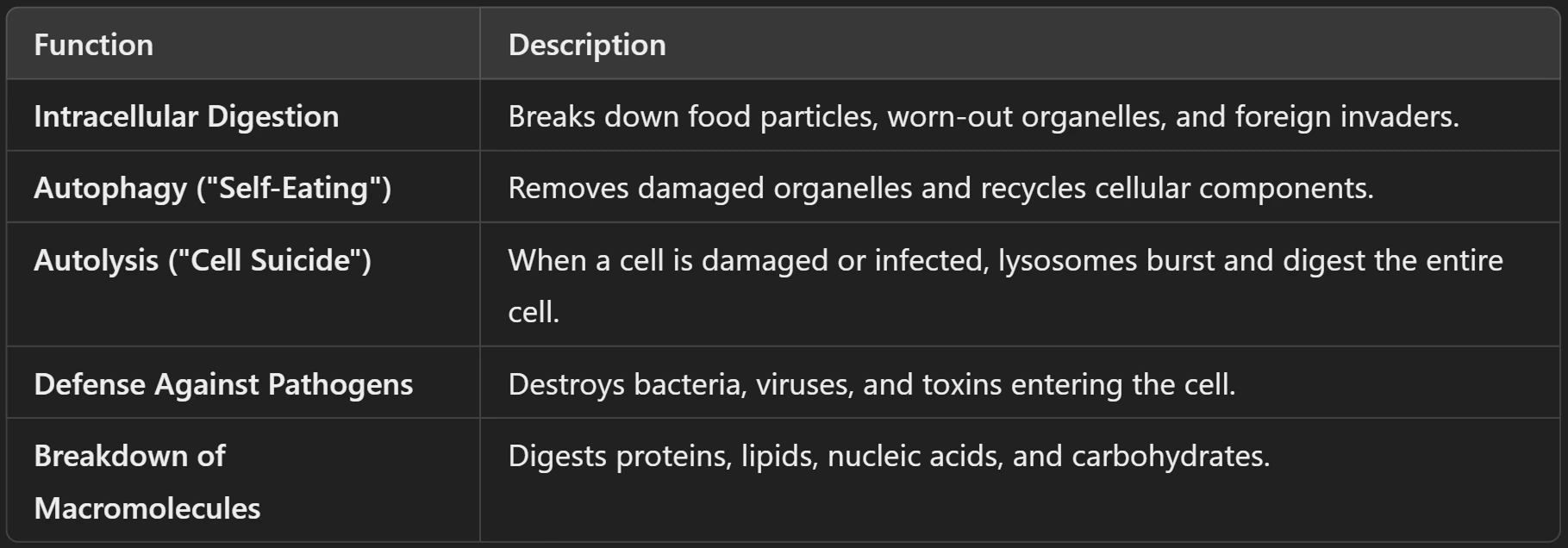
Ans: Mitochondria are double-membrane-bound organelles found in eukaryotic cells, responsible for producing energy in the form of ATP (Adenosine Triphosphate) through a process called cellular respiration.
Structure of Mitochondria
i. Outer Membrane – Smooth and permeable to small molecules.
ii. Inner Membrane – Folded into structures called cristae, increasing surface area for energy production.
iii. Matrix – The inner fluid-filled space containing enzymes, mitochondrial DNA, and ribosomes.
iv. Intermembrane Space – The space between the inner and outer membranes, involved in energy transfer.
Functions of Mitochondria
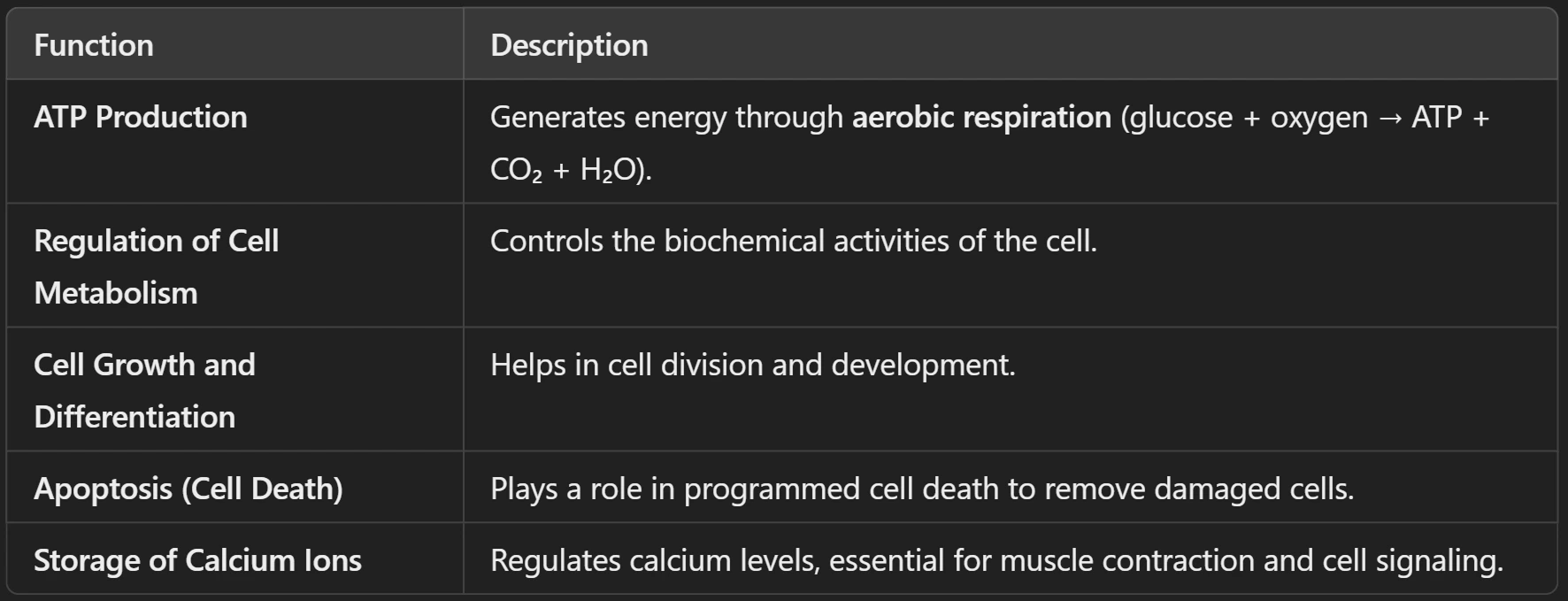
Why is Mitochondria Called the Powerhouse of the Cell?
Mitochondria convert glucose and oxygen into ATP, which is used by the cell for various functions like movement, growth, and repair. Without mitochondria, cells wouldn't have enough energy to survive.
Ans: Plastids are double-membrane-bound organelles found only in plant cells and some algae. They play a crucial role in photosynthesis, storage, and pigmentation.
Types of Plastids

Structure of Plastids
i. Outer Membrane – Smooth and protective.
ii. Inner Membrane – Regulates movement of molecules.
iii. Stroma – Fluid-filled space inside the plastid containing DNA and enzymes.
iv. Thylakoids (in chloroplasts) – Disk-like structures that contain chlorophyll, the green pigment essential for photosynthesis.
Functions of Plastids
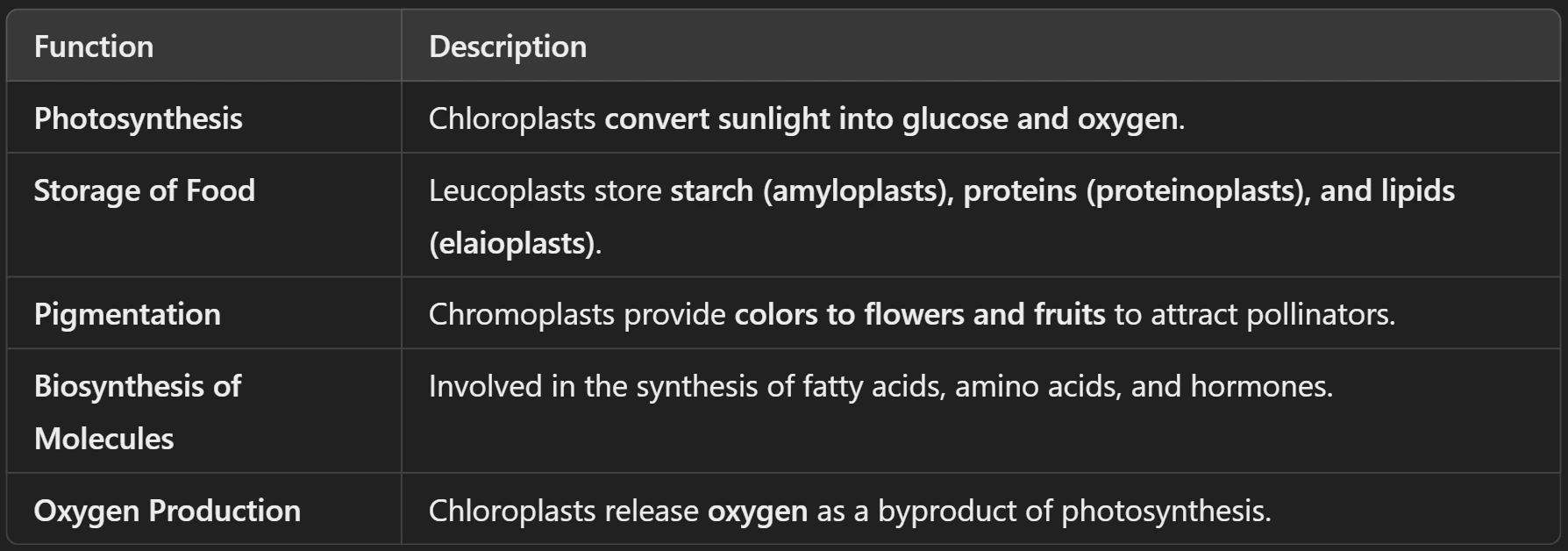
Ans: Vacuoles are membrane-bound organelles found in both plant and animal cells, but they are much larger in plant cells. They act as storage compartments for water, nutrients, and waste products.
Structure of Vacuoles
i. Tonoplast – The outer membrane of the vacuole that controls movement in and out.
ii. Cell Sap – A liquid inside the vacuole that contains water, sugars, ions, pigments, and waste products.
iii. Enzymes & Proteins – Help in digestion and breaking down waste materials.
Functions of Vacuoles

Ans: Cell division is the process by which a parent cell divides into two or more daughter cells. It is essential for growth, repair, reproduction, and maintenance in all living organisms.
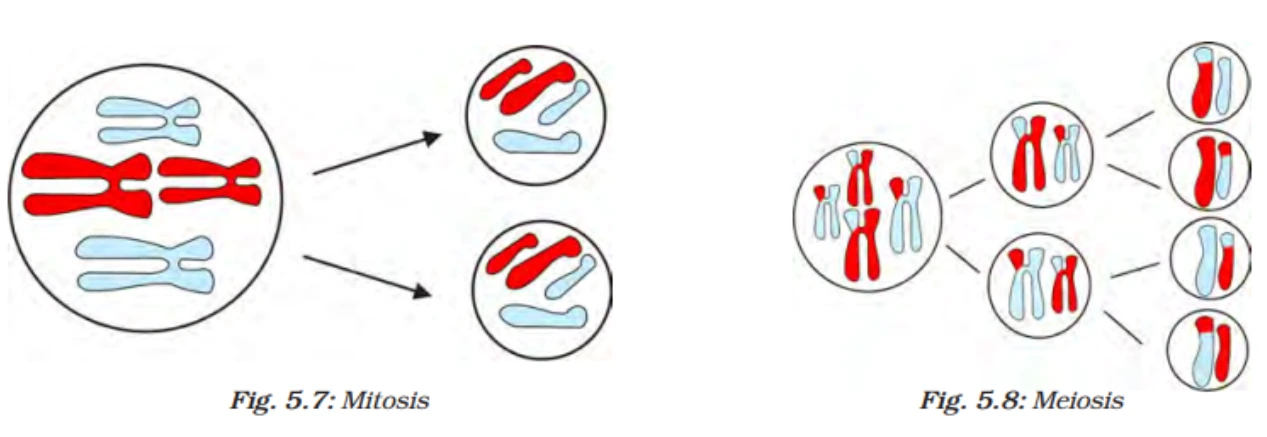
Importance of Cell Division
✅ Growth & Development – Increases the number of cells in a growing organism.
✅ Tissue Repair – Replaces damaged or dead cells.
✅ Reproduction – Creates gametes for sexual reproduction.
✅ Genetic Variation – Ensures diversity in offspring through meiosis.
Types of Cell Division

Do all the differences based on your recent learning from the above concept.





